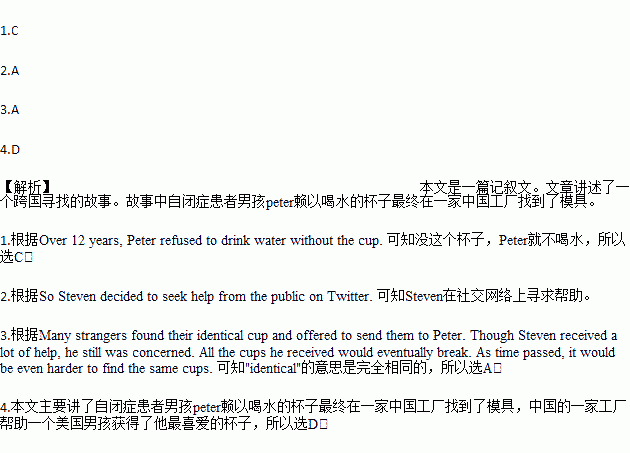题目内容
Steven Williams, an American father of 14-year-old Peter who has autism(自闭症), searched on the Internet to find a specific kind of little blue cup for his son.
When Peter was two, Steven gave him a little blue cup that was made in China and ever since the cup has become one of the most important things in Peter's life. Steven never thought that the little cup would cause such a big pr oblem. Peter became dependent on this cup because ever since he received the gift he would only drink water from the exact type of little blue cup. Over 12 years, Peter refused to drink water without the cup. Steven was worried about this because their current cup could break soon and he needed to find a replacement for his son to drink with. The problem was that the cup was no longer being produced.
oblem. Peter became dependent on this cup because ever since he received the gift he would only drink water from the exact type of little blue cup. Over 12 years, Peter refused to drink water without the cup. Steven was worried about this because their current cup could break soon and he needed to find a replacement for his son to drink with. The problem was that the cup was no longer being produced.
Steven tried to take Peter to a doctor to solve the cup problem, but it was of no use. So Steven decided to seek help from the public on Twitter. He got a lot of responses and the enthusiasm people from all over the world, which gave him confidence and hope. Many strangers found their identical cup and offered to send them to Peter. Though Steven received a lot of help, he still was concerned. All the cups he received would eventually break. As time passed, it would be even harder to find the same cups.
The situation took a surprising turn when the baby products company Tommee Tippee UK got in touch with Steven. They sent a team to China, and they found the same exact model for the cup in the factory that first made it. The company and the Chinese factory decided to make as many as 500 cups for Peter, and Steven was thrilled about all this.
1.What would happen to Peter without the cup?
A. He would feel sad. B. He would break other cups.
C. He would quit drinking water. D. He would suffer from autism.
2.Where did Steven decide to seek help?
A. From a social network. B. From an American company.
C. From a team of researchers. D. From a Chinese factory.
3.What does the underlined word "identical" in Paragraph 3 mean?
A. Exactly alike. B. Nearly broken.
C. Of good quality. D. Of different size.
4.What is the best title for the text?
A. Enthusiastic people Gave Cups to Peter
B. American Boy Preferred Chinese Cup
C. Concerned Father Sought Medical Treatment for Peter
D. Chinese Factory Helped American Boy Get Favorite Cup

